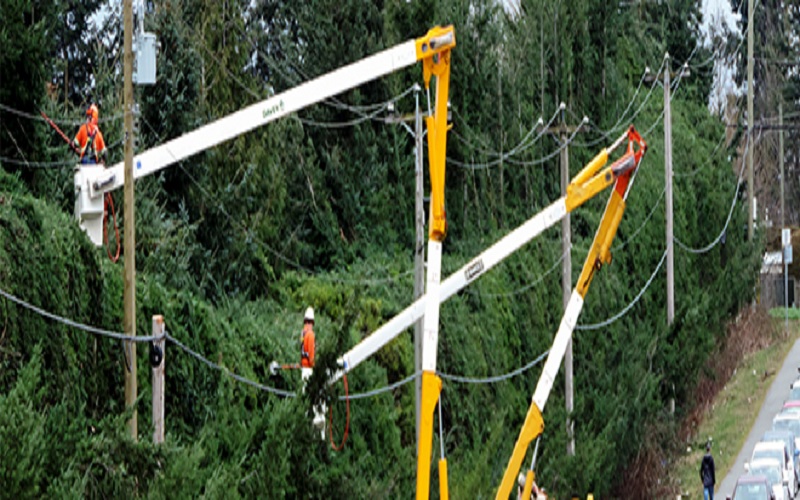Trees are not just part of the landscape but are crucial in maintaining a balanced ecosystem. However, when trees begin to interfere with power lines, it poses a potential threat to both the environment and public safety.
Regular tree maintenance and inspection are pivotal in averting potential hazards and ensuring uninterrupted power supply to homes and businesses. Homeowners facing concerns about trees interfering with power lines can benefit from professional tree services, particularly those with expertise in safe and efficient tree removal.
Green Leaf Zone ensures the secure elimination of hazardous trees, and their team offers comprehensive tree removal services in Los Angeles, CA, in the following areas:
Expert Tree Removal in Los Angeles, CA
Best Tree Removal in Sherman Oaks, CA
Adequate Tree Removal in Calabasas, CA
Professional Tree Removal in Santa Clarita, CA
Ultimately, this guide will explore essential steps to address the challenges posed by trees encroaching on power lines, ensuring a safe and reliable power supply for communities.
Understanding the Risks
Potential Hazards Posed by Trees and Power Lines Interaction
Trees near power lines pose significant risks, ranging from power outages to safety hazards. Overhanging branches can lead to electrical faults, fires, and service interruptions. The potential danger extends to both the community and utility workers. To mitigate these risks, it is imperative to proactively assess and manage tree interactions with power lines.
Environmental and Safety Concerns
Beyond the immediate dangers to power lines, trees’ impact on the environment and safety cannot be overlooked. Untamed vegetation can obstruct sightlines, impede traffic signals, and compromise road safety. Moreover, overgrown trees may become a breeding ground for pests and diseases, further jeopardizing the ecosystem’s overall health.
Legal Implications for Property Owners
Property owners must navigate legal considerations related to tree management near power lines. Failure to address potential hazards may lead to legal repercussions, as property owners could be held responsible for damages caused by neglected trees. Understanding local and national regulations about tree maintenance is paramount for avoiding legal complications.
Tree Assessment and Identification
Conducting a Thorough Site Analysis
Before implementing any tree management strategy, a thorough site analysis is essential. Site-specific factors must be carefully evaluated, such as tree proximity to power lines, soil conditions, and surrounding vegetation. This analysis provides a foundation for developing a tailored approach to tree management that considers the unique characteristics of each location.
Identifying Tree Species Prone to Power Line Interference
Due to their growth patterns and characteristics, certain tree species are more prone to interference with power lines. Identifying these species is a crucial aspect of effective tree management. Property owners can proactively address potential issues before they escalate by recognizing the traits that make certain trees more likely to pose a threat.
Utilizing Technology for Accurate Tree Assessment
Advancements in technology offer invaluable tools for accurate tree assessment. Digital mapping, satellite imagery, and specialized software enable arborists to evaluate tree-critical areas precisely. These technologies enhance the efficiency of identifying potential risks, allowing for targeted interventions and resource optimization.
Regulatory Compliance
Familiarizing with Local and National Regulations
Navigating the regulatory landscape is essential for property owners and arborists involved in tree management. Local and national regulations dictate permissible actions concerning tree trimming, removal, and vegetation control near power lines. Understanding these regulations is fundamental to avoiding legal complications and ensuring compliance.
Obtaining Necessary Permits for Tree Management
Obtaining the requisite permits is a non-negotiable step to undertaking tree management activities near power lines. Property owners must adhere to permitting processes outlined in local regulations, securing approvals before initiating any tree-related work. This proactive approach ensures legal compliance and demonstrates a commitment to responsible and transparent tree management practices.
Ensuring Adherence to Environmental Standards
Environmental considerations should be integral to any tree management plan. Adhering to environmental standards is a regulatory requirement and a responsible approach to preserving biodiversity and ecological balance. Property owners and arborists must incorporate practices that minimize environmental impact, such as proper waste disposal and eco-friendly techniques.
Strategic Tree Pruning Techniques
Implementing Corrective Pruning for Clearance
Corrective pruning is a strategic technique to maintain clearances between trees and power lines. By selectively removing branches that pose a threat, arborists can create a safer environment without compromising the tree’s overall health. This approach minimizes the risk of power outages and enhances the resilience of vegetation to adverse weather conditions.
Promoting Health and Growth While Reducing Interference
Tree pruning should not solely focus on mitigating risks; it should also promote overall tree health and growth. Strategic pruning techniques, such as crown thinning and elevation, allow sunlight penetration and air circulation, fostering a healthier and more resilient tree canopy. This dual approach addresses interference issues while contributing to the long-term well-being of the tree.
Addressing Potential Re-Growth and Monitoring Pruned Trees
After implementing pruning measures, monitoring for potential re-growth is crucial. Regular inspections ensure that previously pruned trees stay intact to problematic growth patterns. This proactive monitoring, coupled with timely corrective actions, prevents the recurrence of issues and maintains the effectiveness of the tree management strategy over time.
Advanced Technologies for Monitoring
Implementing Remote Sensing and Monitoring Tools
Remote sensing technologies provide a dynamic and efficient means of monitoring trees near power lines. Arborists can remotely assess vegetation health, growth patterns, and potential risks through satellite imagery and sensors. This real-time monitoring allows for swift responses to emerging issues, minimizing the need for physical inspections and reducing overall management costs.
Utilizing Drones for Aerial Surveillance
Drones have revolutionized tree management by offering unparalleled aerial views and accessibility. Aerial drone surveillance allows for detailed inspections of tree-critical areas, precisely identifying potential risks. This technology enhances safety, expedites assessments, and provides visual documentation for strategic decision-making in tree management.
Integrating Smart Systems for Real-Time Detection
Smart systems with sensors and monitoring devices offer real-time detection of tree-related issues. These systems can detect changes in tree health, growth, and proximity to power lines, providing instant alerts for intervention. Integrating innovative technologies into tree management strategies ensures a proactive and responsive approach to potential risks.
Collaborative Approaches with Utility Companies
Establishing Communication Channels with Power Companies
Effective communication between tree services and power companies is paramount in ensuring the safety of power lines and trees. By establishing transparent and open channels, parties can exchange vital information regarding upcoming tree management activities and potential concerns. Regular meetings and updates facilitate a collaborative approach to address challenges promptly.
Coordinating Tree Management Efforts with Utility Services
Coordination is key when it comes to managing trees near power lines. Tree services and utility companies must work together to optimize efforts and resources. This involves sharing schedules, plans, and relevant information to ensure a synchronized approach to tree maintenance. Collaborative efforts enhance efficiency and minimize disruptions to power services and community life.
Enhancing Synergy for Efficient Problem Resolution
Enhancing synergy involves developing a mutual understanding of the challenges both tree services and utility companies face. These entities can pool their expertise to address issues efficiently by fostering collaboration. This synergy extends beyond routine maintenance, encompassing quick problem-solving during emergencies or unexpected situations.
Community Awareness and Education
Engaging with Local Communities on the Issue
Community engagement is pivotal in raising awareness about the potential dangers associated with trees and power lines. Tree services should actively participate in community events, town hall meetings, and other gatherings to share insights on the importance of proactive tree management. This engagement helps residents understand the risks and encourages a collective effort to maintain power line safety.
Providing Educational Resources for Property Owners
Empowering property owners with educational resources is essential in promoting responsible tree management. Tree services can create informative materials, workshops, and online resources to educate property owners about identifying potential risks, recognizing signs of tree-related issues, and understanding the importance of regular tree maintenance near power lines.
Fostering a Collective Responsibility for Power Line Safety
Creating a sense of collective responsibility involves instilling that power line safety is a shared concern among residents, businesses, and local authorities. Tree services can collaborate with community leaders to organize campaigns that emphasize the impact of individual actions on overall safety. Encouraging responsible tree planting and maintenance practices is vital in fostering this collective responsibility.
In conclusion, navigating the complexities of trees near power lines demands a strategic blend of technology, collaboration, and community engagement. A comprehensive approach emerges by understanding the risks, adhering to regulations, employing advanced monitoring technologies, and fostering cooperation with utility companies. This ensures a reliable power supply, the preservation of a thriving ecosystem, and the safety of communities




